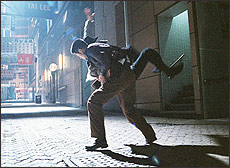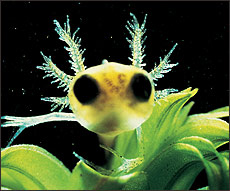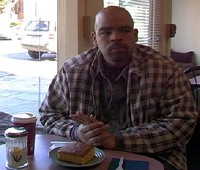Musings
an Online Journal of Sorts
By Alyce Wilson
April 18, 2005 - A Different View

This was the second and final weekend for the Philadelphia Film Festival, and The Gryphon and I saw more movies, starting on Saturday with a film called Throw Down, directed by Johnnie To. This was a really interesting movie, because it was a Judo movie. It's not often that Judo is the style used in a martial arts movie. It was interesting to see those techniques, as fighters thrown each other down and grappled. It's a very different kind of style from the Kung Fu or Karate used in most martial arts movies, concentrating on punching and kicking.
Throw Down is one of the rare martial arts movies that actually concentrates on the story. For that reason, it stands out and makes an emotional impact, moving easily between humor and drama.
 The
next film we saw was at the same theater, Ritz East. It was Genesis,
directed by Claude Nuridsany and Marie Perennou. It was in French and
was a creative documentary, taking a poetic look at the origins of life
and the interconnectedness of different life forms.
The
next film we saw was at the same theater, Ritz East. It was Genesis,
directed by Claude Nuridsany and Marie Perennou. It was in French and
was a creative documentary, taking a poetic look at the origins of life
and the interconnectedness of different life forms.
The movie was beautifully done, using some of the best nature photography available to illustrate the concepts, as well as plenty of natural sound from animals, insects and natural phenomena.
We were enjoying it a great deal, but then at one point, during a reel change, the film was suddenly upside down and backwards. They had to stop while they figured out what had happened. Now, the film was on 35mm, which really presented a problem. If it had been on 16mm, they would have been switching back and forth between two projectors. This would have meant all they'd have to do is rewind one reel and cue it up probably, something that could have been fixed in about five minutes.
But 35mm projectionists typically slice all the reels together onto one large reel and show them all at once, breaking them down again into separate reels and restoring the headers and footers when they return the film to the projector.
I knew this would take a long time to fix. The best guess I had was that somebody who had shown the film previously had put the head and tail back improperly. Once they got it fixed, about 20 minutes later, more of the mystery arrived. The portion we had seen was not the end of the movie, which meant that only about 10 minutes of the film had been upside down. The reason this is strange is that movies tend to be shipped in 20-minute reels. Either somebody who showed the film previously had the film break in the booth and then spliced it together wrong, or somebody at the distributing house messed up badly.
At any rate, the film was worth finishing, and we did enjoy it. A very gentle, beautiful film.
We had scheduled ourselves so that we would have a break between this film and the next one, which was across town at the International House on the University of Pennsylvania campus. With this delay, however, we had to rush. We just barely make it, because fortunately they didn't start the film right on time.
This showing was a group of short films called "More Things in Heaven and Earth." We enjoyed this short films program a lot; several of them were very good.
First in the run-down was "What is Animation?" by Liesje Kraai. This was a cute concept. The director had interviewed people in the street about their views of animation and then animated their replies. It was a creative experiment that worked well.
Next was another animated piece, "Piano Dog Visits the Underworld" by Karl Staven. It was a surreal computer animated work where Piano Dog and his fellow band members rescue their friend from the underworld and from some world destroying dogs. The film was in a made-up language, with translations, and it had the feel of a foreign movie, in that sometimes there were jokes or actions that seemed lost in translation, if you will. In the question and answer session afterwards, Staven revealed that the film had originally been nearly a half-hour long and that he had cut it down because it wasn't working. This explains why sometimes the action seemed to jump.
One of the audience favorites was a wacky piece called "Sweettooth" by Robert ToTeras, who had come back to Philly from L.A. to debut the film. The movie was a humorous, ridiculous slice of life of a young woman whose strange mannerisms and difficulty talking to people have turned her existence into a lonely one, highlighted by her nightly candy binges. The film was well done, and the acting was great. The director talked about the making of the film, and especially how much work he had done with the actress to develop the character's strange mannerisms. She was present, and in person was a very attractive young lady, nothing like the strange character she portrayed on screen. The back story is that he came up with the idea while working at a job he didn't like, at a law firm in Philadelphia. She was his boss at the time and agreed to be in the film. He said that the piece was inspired by the Jean-Luc Godard film Vivre Sa Vie (My Life to Live), which tells the story of a woman's life through vignettes. He said he wanted to do a clownish version of that.
An animated piece called "Trouble with Harry" by William Greenawalt and Hugo Marmugi is an animated version of an old novelty record where a man complains about his stubborn piano player, who refuses to play the correct song. They animated this using a combination of stop motion animation with wooden puppets and some computer compositing.
"Mouina (The Tree") by Marc Brodzik and Andrew Gelter was a short subject documentary about a woman who has kept her Christmas tree up for 15 years, decorating it with photographs of her family and friends so that the shrine has taken over a good section of her apartment. The film got into her philosophies of life and her views on environmentalism, aging and other topics. They said during the Q&A that they intend to go back into the editing room again, at the subject's request. It did seem like it could be tweaked in many places and tightened, as well. The director said he had met Mouina at a diner party she had and was fascinated by the tree, which makes both an environmental statement about waste as well as a personal/artistic statement. It also looks like quite the fire hazard, to be honest, especially since she still has lights on it.
 One
of my favorites was called "Forget Tomorrow" by Shannon
Newby. It was a very simple movie, set in a coffee shop, where a guy
known as the Numbers man, who assigns numbers to each of them. Among the
coffee shop customers are a self-involved businessman, a gregarious young
guy quick with jokes, an uptight young woman about to be married to an
abusive boyfriend. At the end, there's an interesting twist I won't spoil
for you but which makes you want to watch the entire thing over again.
One
of my favorites was called "Forget Tomorrow" by Shannon
Newby. It was a very simple movie, set in a coffee shop, where a guy
known as the Numbers man, who assigns numbers to each of them. Among the
coffee shop customers are a self-involved businessman, a gregarious young
guy quick with jokes, an uptight young woman about to be married to an
abusive boyfriend. At the end, there's an interesting twist I won't spoil
for you but which makes you want to watch the entire thing over again.
During the
Q&A, Newby said he was inspired to do the movie from watching a behind-the-scenes
documentary on Taxi Driver, where the taxi driver, played by Robert
De Niro, and the young prostitute, played by Jodie Foster, are talking
in a diner. He said he found himself wondering about the inner thoughts
those characters had while not talking.
"Ellie and the Icarus Kite" was an animated piece by Dan Gauthier. In the first few seconds is some very beautiful animation of a lightning bug walking across a stick. Then the story changes focus to a girl, saddened by her goldfish dying, who follows him out to sea on a kite, only to be swallowed by a fish. This piece was very dreamlike and used various animation techniques.
The final piece, "Ye Olde Enterprise LLC" by Benjamin Berman, was one of The Gryphon's favorites. The film tells the story of a man living with his mother and stepfather who decides to start a pretzel business in Old City. When the enterprise fails to produce results, his parents pay a tough talking rabbi to knock some sense into him. The short was entertaining and very silly. I especially liked the scenes with the rabbi, and I asked the director in the Q&A whether he'd been influenced by The Godfather while shooting those scenes. He said no but they were influenced by his real life experiences with rabbis!
Afterwards,
we walked to a nearby Cosi, where we shared a tray of brie and fruit and
talked about what we'd seen that day.
More musings from the 2005 Philadelphia Film Fest:
April 11, 2005 - Film Style 5+
April 12, 2005 - Short and Sweet
April
19, 2005 - Last of the Fest
Musings on the 2004 Philadelphia Film Fest:
April 12, 2004 - Indulging in Film
April 19, 2004 - Beyond Tragic Consequences
Moral:
Taking a different look at the world helps you to view it more clearly.
Copyright
2005 by Alyce Wilson
What
do you think? Share your thoughts
at Alyce's message board (left button):
![]()
![]()

